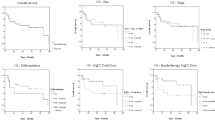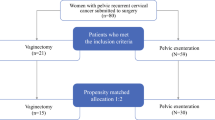Abstract
Purpose
The effectiveness of vaginectomy compared to that of local tumor excision (LTE) for the International Federation of Gynecology and Obstetrics (FIGO) stage I and II vaginal carcinoma is unclear. We aimed to clarify if the effectiveness of vaginectomy is comparable to that of LTE in the real world.
Methods
We retrospectively evaluated data of patients with primary vaginal carcinoma registered in the Surveillance, Epidemiology, and End Results Program (SEER) database from 2004 to 2016. The multivariate Cox proportional hazards models and Fine-Gray competing risk models were used to estimate the overall survival (OS) and disease-specific survival (DSS) after propensity score matching.
Results
Of the 533 patients with FIGO stage I and II primary vaginal carcinoma, 243 and 290 patients were treated with vaginectomy and LTE, respectively. Vaginectomy was significantly associated with improved OS [unadjusted hazard ratio (HR) = 0.70, 95% confidence interval (CI) 0.53–0.95, P = 0.020; adjusted HR = 0.63, 95% CI 0.46–0.87, P = 0.005] and DSS [unadjusted subdistribution HR (sHR) = 0.75, 95% CI 0.52–1.07, P = 0.115; adjusted sHR = 0.65, 95% CI 0.44–0.97, P = 0.036]. Age, marital status, histology type, FIGO stage, chemotherapy, and lymph node metastases were significant prognostic factors of survival. Moreover, radiotherapy did not influence the effectiveness of vaginectomy. Subgroup and sensitivity analysis confirmed the consistent beneficial effectiveness of vaginectomy.
Conclusion
Compared with LTE, vaginectomy results in significantly prolonged survival in patients with FIGO stage I and II primary vaginal carcinoma. Thus, it can be the preferred treatment for FIGO I and II vaginal cancer regardless of radiotherapy status.


Similar content being viewed by others

Data availability
All the data analyzed in this study can be found at https://seer.cancer.gov/.
Code availability
Not applicable.
References
Siegel RL, Miller KD, Jemal A (2018) Cancer statistics, 2018. CA Cancer J Clin 68(1):7–30
Pingley S, Shrivastava SK, Sarin R et al (2000) Primary carcinoma of the vagina: Tata Memorial Hospital experience. Int J Radiat Oncol Biol Phys 46(1):101–108
Frank SJ, Deavers MT, Jhingran A et al (2007) Primary adenocarcinoma of the vagina not associated with diethylstilbestrol (DES) exposure. Gynecol Oncol 105(2):470–474
Hiniker SM, Roux A, Murphy JD et al (2013) Primary squamous cell carcinoma of the vagina: prognostic factors, treatment patterns, and outcomes. Gynecol Oncol 131(2):380–385
Aridgides P, Onderdonk B, Cunningham M et al (2016) Institutional experience using interstitial brachytherapy for the treatment of primary and recurrent pelvic malignancies. J Contemp Brachyther 8(3):175–182
Frumovitz M, Etchepareborda M, Sun CC et al (2010) Primary malignant melanoma of the vagina. Obstet Gynecol 116(6):1358–1365
Nomura H, Matoda M, Okamoto S et al (2016) Clinical characteristics of non-squamous cell carcinoma of the vagina. Int J Gynecol Cancer 25(2):320–324
Huertas A, Dumas I, Escande A et al (2018) Image-guided adaptive brachytherapy in primary vaginal cancers: A monocentric experience. Brachytherapy 17(3):571–579
Laliscia C, Gadducci A, Fabrini MG et al (2017) Definitive radiotherapy for primary squamous cell carcinoma of the Vagina: Are high-dose external beam radiotherapy and high-dose-rate brachytherapy boost the best treatment? experience of two italian institutes. Oncol Res Treatment 40(11):697–701
Manuel MM, Cho LP, Catalano PJ et al (2016) Outcomes with image-based interstitial brachytherapy for vaginal cancer. Radiother Oncol 120(3):486–492
Laliscia C, Fabrini MG, Delishaj D et al (2016) Concomitant external-beam irradiation and chemotherapy followed by high-dose rate brachytherapy boost in the treatment of squamous cell carcinoma of the vagina: a single-center retrospective study. Anticancer Res 36(4):1885–1889
Ditto A, Bogani G, Martinelli F et al (2016) Surgical management and prognostic factors of vulvovaginal melanoma. J Low Genit Tract Dis 20(3):E24–E29
Gardner CS, Sunil J, Klopp AH et al (2016) Primary vaginal cancer: role of MRI in diagnosis, staging and treatment. Br J Radiol 88(1052):20150033
Gadducci A, Fabrini MG, Lanfredini N et al (2016) Squamous cell carcinoma of the vagina: natural history, treatment modalities and prognostic factors. Crit Rev Oncol Hematol 93(3):211–224
Cutillo G, Cignini P, Pizzi G et al (2006) Conservative treatment of reproductive and sexual function in young woman with squamous carcinoma of the vagina. Gynecol Oncol 103(1):234–237
Yin D, Wang N, Zhang S et al (2013) Radical hysterectomy and vaginectomy with sigmoid vaginoplasty for stage I vaginal carcinoma. Int J Gynecol Obstet 122(2):132–135
Jain V, Sekhon R, Giri S et al (2016) Role of radical surgery in early stages of vaginal cancer-our experience. Int J Gynecol Cancer 26(6):1176–1181
Li YY, Chen Y, Xu HC et al (2012) Laparoscopic nerve-sparing radical vaginectomy in patients with vaginal carcinoma: surgical technique and operative outcomes. J Minim Invasive Gynecol 19(5):593–597
Ling B, Gao ZX, Sun MW et al (2008) Laparoscopic radical hysterectomy with vaginectomy and reconstruction of vagina in patients with stage I of primary vaginal carcinoma. Gynecol Oncol 109(1):92–96
Nation Cancer Institute. Appendix C: Site Specific Coding Modules - 2016 SEER Coding and Staging Manual. SEER https://seer.cancer.gov/archive/manuals/2016/appendixc.html. Accessed 29 2020
Van Dyne EA, Henley SJ, Saraiya M et al (2018) Trends in human papillomavirus-associated cancers—United States, 1999–2016. MMWR Morb Mortal Wkly Rep 67(33):918–924
Adams TS, Cuello MA (2018) Cancer of the vagina. Int J Gynecol Obstet 143:14–21
Rajaram S, Maheshwari A, Srivastava A (2016) Staging for vaginal cancer. Best Practice Res Clin Obst Gynaecol 29(6):822–832
Di Donato V, Bellati F, Fischetti M et al (2012) Vaginal cancer. Crit Rev Oncol Hematol 81(3):286–295
Saito T, Tabata T, Ikushima H et al (2018) Japan Society of gynecologic oncology guidelines 2016 for the treatment of vulvar cancer and vaginal cancer. Int J Clin Oncol 23(2):201–234
American Cancer Society. Surgery for Vaginal Cancer.https://www.cancer.org/cancer/vaginal-cancer/treating/surgery.html. Accessed 29 2020
Tjalma WAA, Monaghan JM, Lopes AD et al (2001) The role of surgery in invasive squamous carcinoma of the vagina. Gynecol Oncol 81(3):360–365
Stock RG, Chen AS, Seski J (1995) A 30-year experience in the management of primary carcinoma of the vagina: analysis of prognostic factors and treatment modalities. Gynecol Oncol 56(1):45–52
Rajagopalan MS, Xu KM, Lin JF et al (2014) Adoption and impact of concurrent chemoradiation therapy for vaginal cancer: a National Cancer Data Base (NCDB) study. Gynecol Oncol 135(3):495–502
Janco JM, Markovic SN, Weaver AL et al (2013) Vulvar and vaginal melanoma: case series and review of current management options including neoadjuvant chemotherapy. Gynecol Oncol 129(3):533–537
Tcheung WJ, Selim MA, Herndon JE 2nd et al (2012) Clinicopathologic study of 85 cases of melanoma of the female genitalia. J Am Acad Dermatol 67(4):598–605
Hacker NF, Eifel PJ, van der Velden J (2016) Cancer of the vagina. Int J Gynaecol Obstet 131(Suppl 2):S84–S87
Ikushima H, Wakatsuki M, Ariga T et al (2018) Radiotherapy for vaginal cancer: a multi-institutional survey study of the Japanese radiation oncology study group. Int J Clin Oncol 23(2):314–320
Miyamoto DT, Viswanathan AN (2013) Concurrent chemoradiation for vaginal cancer. PLoS ONE 8(6):e65048
Wolfson AH, Reis IM, Portelance L et al (2016) Prognostic impact of clinical tumor size on overall survival for subclassifying stages I and II vaginal cancer: a SEER analysis. Gynecol Oncol 141(2):255–259
Aktas M, de Jong D, Nuyttens JJ et al (2007) Concomitant radiotherapy and hyperthermia for primary carcinoma of the vagina: a cohort study. Eur J Obstet Gynecol Reprod Biol 133(1):100–104
Acknowledgements
The authors acknowledge the efforts of the SEER Program registries in the establishment of the SEER database.
Funding
None.
Author information
Authors and Affiliations
Contributions
PD contributed to the manuscript editing and writing, project development, and supervision. YY contributed to the data analysis, manuscript editing, methodology, and software. ZW contributed to the data collection or management, manuscript editing and writing formal analyses, and project development.
Corresponding author
Ethics declarations
Conflict of interest
The authors declare that they have no conflict of interest.
Ethics approval
This is an observational study. The Research Ethics Committee of Shengjing Hospital affiliated China Medical University has confirmed that no ethical approval is required.
Informed consent
The information was accessed from the SEER database, and the requirement for informed consent was exempted by the Review Board of Shengjing Hospital affiliated China Medical University.
Additional information
Publisher's Note
Springer Nature remains neutral with regard to jurisdictional claims in published maps and institutional affiliations.
Electronic supplementary material
Below is the link to the electronic supplementary material.
Rights and permissions
About this article
Cite this article
Zhou, W., Yue, Y. & Pei, D. Survival benefit of vaginectomy compared to local tumor excision in women with FIGO stage I and II primary vaginal carcinoma: a SEER study. Arch Gynecol Obstet 302, 1429–1439 (2020). https://doi.org/10.1007/s00404-020-05737-6
Received:
Accepted:
Published:
Issue Date:
DOI: https://doi.org/10.1007/s00404-020-05737-6



